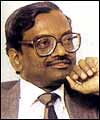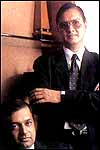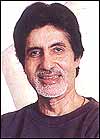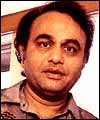













|
COVER
STORY
Rigged!
In one corner, there's big bull Ketan Parekh who reportedly used bank
funds to take stock prices up to unrealistic levels. In the other, is a
bear cartel, known to the former BSE president, that sought to trap Parekh,
and make a killing in the process. A ringside account of the murky deals.
By Brian
Carvalho
 Let's
start with the bloodbath. An erosion of almost Rs 1.5 lakh crore in market
capitalisation and a loss of 700 points in the Bombay Stock Exchange (BSE)
Sensex in just eight days. A 900-point gyration in the 30-share index in
one single trading day (on March 13), the wildest in the bourse's 125-year
history. The Calcutta Stock Exchange is still sitting on a default
time-bomb. That there isn't a full-blown payments crisis there is thanks
largely to the intervention of a cash-rich former broker and a decision to
stagger the payments due. All the broker directors on the Bombay Stock
Exchange are suspended by the Securities & Exchange Board of India for
alleged insider trading. The head of surveillance at the BSE is shunted.
Meantime, the Ahmedabad Stock Exchange executive director puts in his
papers. The UTI Bank-Global Trust Bank merger lands on the rocks. A
cooperative bank in Ahmedabad faces a run on its deposits. And, yes, big
bull Ketan Parekh's horns are clipped, finally. Let's
start with the bloodbath. An erosion of almost Rs 1.5 lakh crore in market
capitalisation and a loss of 700 points in the Bombay Stock Exchange (BSE)
Sensex in just eight days. A 900-point gyration in the 30-share index in
one single trading day (on March 13), the wildest in the bourse's 125-year
history. The Calcutta Stock Exchange is still sitting on a default
time-bomb. That there isn't a full-blown payments crisis there is thanks
largely to the intervention of a cash-rich former broker and a decision to
stagger the payments due. All the broker directors on the Bombay Stock
Exchange are suspended by the Securities & Exchange Board of India for
alleged insider trading. The head of surveillance at the BSE is shunted.
Meantime, the Ahmedabad Stock Exchange executive director puts in his
papers. The UTI Bank-Global Trust Bank merger lands on the rocks. A
cooperative bank in Ahmedabad faces a run on its deposits. And, yes, big
bull Ketan Parekh's horns are clipped, finally.
Now for the dawn that's emerged as the
bourses burned down. You probably won't see a broker on the governing
boards of stock exchanges anymore. If a broker does make it as president,
vice-president, or treasurer, thanks to the code of ethics put in place by
SEBI, these officials will not be allowed to trade in shares. Rolling
settlements-which ensure that the settlement takes place five days after
trading-will now be made compulsory in 200 mainline scrips. Inordinate
speculation, or rather rampant manipulation, will be curbed. But, most
significant, the cosy brokers' club has been disbanded.
Indeed, the upheaval that hit Dalal Street
last fortnight makes a mockery of the BSE's avowed Mission 2001:
Technology-Savvy, Investor-Friendly, Global Exchange. So it said. You have
to wonder why the Dirty Tricks Department doesn't get a mention.
Did the BSE say investor-friendly? Why
then, for over two years, was Ketan Parekh given a free hand to manipulate
share prices and take them up to unrealistic levels, which in turn spurred
hundreds of 'mini-KPs'-as they're known on the Calcutta exchange-to join
the party? Why was the BSE President Anand Rathi calling up the
surveillance department of the exchange to inquire about operator
positions in KP stocks-HFCL, Zee Global and DSQ-when he had no business
doing so? And was Rathi, along with his coterie of brokers, deliberately
hammering down prices over the last three months in a bid to trap KP-and
of course make a killing in the bargain?
Ironically, Rathi's downfall was triggered
from within the exchange itself-which only highlights the bitter rivalries
and unbridled ambitions that have been running riot within the 28 floors
of Phiroze Jeejeebhoy Towers, otherwise known as the Bombay Stock
Exchange. Spend some time within those not-so-hallowed walls and you'll
probably hear brokers talking about the machinations of the Jodhpur Club,
presided by none other than Rathi himself. If you know them well enough,
they'll also mention 'The Nipple', none other than Executive Director A.N.
Joshi. Reason for that name? He never opens his mouth, and apparently
resides snugly in the president's pocket. That Rathi had to dig into the
surveillance details on March 1 was only because the ED wasn't present in
the exchange on that day, point out exchange sources. ''He was the conduit
between the exchange and the surveillance department. He's completely sold
out to the president,'' adds the source. When contacted, Rathi refused to
speak to BT.
How The Gangrene Spread
|
|

RAMESH
GELLI
Ketan Parekh, say sources, was responsible for the spurt in Ramesh
Gelli's GTB in mid-October. The rigging skewed the swap ratio in
GTB's favour vis-a-vis UTI Bank.
|
|

V.
MALOO & M. NAHATA
KP and HFCL Chairman Vinay Maloo are great friends, but HFCL
officials scoff at any suggestion that the two got together to
artificially prop up the company stock.
|
|

JAMES
PACKER
With Vinay Maloo and James Packer, Parekh floated the $250-million
KVP Fund, which focuses on biotech and convergence. The fund
invested in only one portal before folding up.
|
|
Let's for a moment cross over to the
Calcutta exchange, which in comparison makes the BSE look like a temple.
One broker calls it the 'gangrene of the Indian markets'. Actually, it's
difficult to believe that it exists. For, much of the transactions there
happen directly between individuals. So the exchange receives no margin
money, has no records of any transactions, and the carry-forward rates are
'unofficial' (and even carried in newspapers). So if the official rate is
12 per cent on BADLA transactions, positions in Calcutta are carried
forward at 50-100 per cent higher rates. ''That's how exposures went
beyond control, and brokers were forced to default,'' says a Mumbai
broker. That's also how Rs 2,000 crore of BADLA finance disappeared from
the Calcutta market, triggering off the possibility of a payments crisis.
That Calcutta managed to avert the
crisis-or should we say postpone it?-was thanks largely to the efforts of
Sevantilal Shah. Who's he? Good question. All we know is that he isn't an
active broker any more. But he's rich. And he apparently stepped in with
Rs 250 crore to ensure that the payments crisis did not happen on Friday
15. A temporary solution- of a staggered payment-has been proposed at the
overheated counters like HFCL and DSQ. Finance has been organised to bail
out the defaulting brokers and for the moment the trade guarantee fund may
not be ransacked. But the question is: can players Dinesh Singhania,
Harish Biyani, and Ashok Poddar keep to the payment schedule?
The defaults last fortnight were largely in
the KP stocks-HFCL, DSQ, SSI, and GTB. ''The reason is the nature of the
purchases made at these counters,'' says Vivek Mahajan, a former
Vice-President at the CSE. What he does not say is that, in the first week
of March, brokers like Singhania, Poddar, Biyani and Pramod Maheswari have
repeatedly stepped in to provide support to the KP stocks without
providing for adequate cover. That resulted in the first default, of Rs 96
crore, on March 8. That's when Singhania, a governing body member with a
huge exposure of around Rs 40 crore in the HFCL counter, resigned from the
CSE board. And Biyani, who was active on the DSQ counter along with KP,
was declared a defaulter.
According to market insiders, the brokers
in the KP stable-like Poddar, Biyani and Maheshwari-firmly believed that
the KP magic would pull them through. But that didn't happen. That these
stocks were hugely overvalued only compounded the crisis. ''The bears are
being blamed for bringing the market down but the fact of the matter is
the stocks that are shedding weight are doing so because they were hugely
overpriced. The Rs 1,100 HFCL price in October 2000 is completely unreal
and there is no reason why we should not take advantage of the situation
now prevailing (by short-selling),'' says Ajay Kayan of C. Mackertich, a
firm that is being probed by SEBI for bringing down the market. What we
did was perfectly legal and in fact we have exposed the bubble,'' he goes
on. Adds Radhakishan Damani, Chief of Damani Shares & Stock Brokers:
''You have to remember that the trigger for the selling came from the
NASDAQ. After all, the NASDAQ has fallen by over 60 per cent from its
peak, as against which the Dow is down by just 15 per cent.'' Damani,
along with brother Gopikishan, was also investigated by SEBI as his firm's
name sprung up on the taped conversation between the BSE President and the
surveillance department. ''I have made it clear to SEBI that neither me
nor my brother nor any of our companies and associates have shortsold
shares in the current financial year,'' says R.K. Damani.
Yet, the bear cartel theory can't just be
wished away. SEBI, for its part, has seen some substance in it, and zeroed
in on First Global Securities, Credit Suisse First Boston, Anand Rathi,
and Nirmal Bang. According to BSE insiders, if Rathi is the head of the
Jodhpur Club, Bang is his second-in-command. A couple of years ago, Bang
was just another sub-broker, at Suresh Rathi & Co, a broking firm
owned by Anand Rathi's brother Suresh. Now Anand was a partner in that
firm too. ''Since then, he's risen phenomenally and today he owns four or
five BSE cards, officially,'' says an insider.
He goes on to add that since the beginning
of January 1, this cartel would meet periodically and plan out their
hammering strategies. The last such meeting was held immediately after
Yashwant Sinha's pro-markets Budget, which propelled the Sensex by 177
points. And the effects of the hammering were on display on March 2 (a
Friday), when the index lost all those gains.
Where The Bears Crossed The Line
|
|

AMITABH
BACHCHAN
Ketan Parekh spared some Rs 50 crore to help Amitabh Bachchan pay
back his creditors, besides restructuring the operations of AB Corp
to make it a debt-free company.
|
|

AMAR
SINGH
Samajwadi Party General Secretary Amar Singh used his birthday bash
to collect funds for earthquake relief in Gujarat. Ketan Parekh
contributed Rs 21 lakh, which, coincidentally, is the same amount
donated by HFCL founders Vinay Maloo and Mahendra Nahatta.
|
|

BHARAT
SHAH
When film financier Bharat Shah was arrested in early January, media
and entertainment stocks in which KP had an exposure came crashing
down as punters feared that KP had invested roughly Rs 150 crore of
Shah's dubious money in these shares. |
|

HARSHAD
MEHTA
Comparisons with Harshad Mehta are inevitable- they're still
close-but the biggest differences are KP's conscious effort to stay
away from the arclights of the media, and his reluctance to flash
his riches.
|
|
Of course, as Kayan points out, the bears
were justified in hammering stock that they perceived to be overvalued.
But where Rathi crossed the line was when he dialled up surveillance for
sensitive details of operators' long and short positions in the so-called
momentum stocks. What's more, it's the modus operandi of the cartel that
begs investigation. Sources reveal that the bears not only shortsold huge
quantities of shares, but also managed to deliver them. How?
By borrowing from custodians, in this case
mainly from the Stock Holding Corporation of India (SHCIL), the custodian
for the Unit Trust of India. Here's how it worked. The bear cartel first
shortsold a huge chunk of HFCL, Zee and Global Tele stock. They then
borrowed these shares after paying by cheque plus 20 per cent in margin
money. This can't be confirmed, but apparently 1 crore shares of Zee at Rs
250, and 1 crore shares of HFCL at Rs 800, totally worth Rs 1,050 crore,
were shortsold and then borrowed.
Five days before settlement, the bears
delivered these shares in the market. So not only have the bears not
covered their positions but they've delivered the borrowed stock,
resulting in huge liquidity in the market. Naturally, with no buyers
present, the price of these stocks plummeted, and the bull in those
shares-read KP-is stranded. It doesn't end there.
The money received at pay-out after giving
delivery was used to buy up more of that stock at lower prices. After all,
those shares have got to be returned to the borrower. But the bears by
then have made a neat killing, and that sum is used to borrow more shares
and repeat the exercise. Thus, at an investment of just a 20 per cent
margin, the bears were actually raking in returns that were much higher
than the value of the securities they borrowed. For, the prices of those
stocks had fallen by more than half-Zee, for instance, had come down to Rs
100 levels. Unconfirmed reports suggest that the bear cartel raked in over
Rs 3,000 crore in this manner since January 1.
How many retail investors have been hit is
anybody's guess, but it's clear that the Big Bull's magic is over, for
now. His famous K-10 index-which punters swore by-is a burnt-out case,
with some of those stocks plummeting by as much as 90 per cent since their
peaks early last year. Zee, for instance, had climbed to 2,330 last
February, Himachal to Rs 2,553 and Global to Rs 3,550. Hold on, was the
market buzz, the ride's not yet over. Global, for instance, was expected
to touch Rs 5,000. As on March 14, HFCL had dropped to the Rs 194 range,
Global around Rs 180 and Zee Rs 127. Then there's another KP favourite,
DSQ, which KP took to Rs 2,820. The price as on March 14? Rs 127. Of
course, whilst bear hammering did play its part, the trigger did come from
NASDAQ's disenchantment with tech stocks. That the bears could indulge in
such an operation was possible only because the overall trend was down.
For, if prices of the stock borrowed by them had to go up, the bears
themselves would have been trapped by the ballooning high margin rates
they would have had to pay the stock lenders.
That the erosion in his favourite scrips
resulted in a funds crunch for KP is amply evident in the woes of the
banks that lent to him. The Ahmedabad-based Madhavpur Cooperative Bank,
which is rumoured to be controlled by KP himself, faced a run on its
deposits because the bull was not able to pay back his borrowings. As a
result, the bank had little option but to sell the shares it held as
collateral, adding further fuel to the hammering the KP stocks were anyway
receiving.
So now you know where KP was getting his
funds from. There's Global Trust Bank (GTB), too, which lent a chunk of
its Rs 500-odd crore exposure in the capital markets to KP and his myriad
companies. GTB officials have claimed that it demands a 133 per cent
collateral for financing pay-ins. This obviously meant that there was
plenty of pressure on KP to meet those collateral norms, which are fixed
as a percentage of the shares' market value, when prices were falling. The
bank, for its part, too would like to cut its losses by selling the
collateral, although GTB officials have denied this.
|
| 1992:
One of the co-accused in the Harshad Mehta-triggered
securities scandal, along with the likes of Ajay Kayan and Bhupen
Dalal. |
| 1998: Harshad
Mehta fades into the shadows, after his rigging of BPL, Sterlite,
and Videocon share prices is exposed. |
| Early
1999: Enter Ketan Parekh. Buys into
small-cap infotech and telecom stocks like Aftek, Global
Tele-systems, and HFCL. The K-10 index is born. |
| Early
2000: The K-10 index is at a high. Aftek is
at a mind-boggling Rs 5,000; KP had got into the stock at Rs 26.50.
Global and HFCL hit record highs too-Rs 3,550 and Rs 2,553. |
| March: Markets
crash, Sensex plunges from a high of 6,000. KP pulls out Rs 1,200
crore from the market, reveal sources. |
| 2000
April: KP shuns the market and tries to
play VC. Along with buddies Vinay Maloo and James Packer, he floats
the $250-million KVP Fund. Sources suggest that the partners haven't
bought funds to the table, it's just the cash KP pulled out of the
Indian markets. |
| August: The
KVP Fund doesn't take off, having just one investment to show for
its efforts. KP now takes a fancy to media and entertainment stocks.
Picks up chunky stakes in companies like Mukta Arts, Balaji
Telefilms, Tips Industries, Creative Eye, and Pritish Nandy
Communications. All these stocks duly start soaring. KP is back in
the market. Gets back into his favourite stocks, along with some new
ones like Padmini Polymers. |
| December
2000- February 2001: Rumours and the
subsequent arrest of Bharat Shah send media & tech stocks
crashing. Around the same time, tech stocks in the US start falling.
KP's portfolio is eroded. |
| March
2001: Despite a pro-market Budget, the
Sensex goes into a nosedive, triggered ostensibly by a bear cartel.
Parekh is trapped. |
|
KP may emerge unscathed if his borrowings
from GTB are investigated. Since, although the figure may be over the RBI-stipulated
20 per cent of the bank's net worth (which is Rs 550 crore), the
individual exposures of all his associate companies might just about meet
those norms. But where SEBI has been able to dig up dirt on KP is in his
involvement in the rigging of the GTB scrip prior to the merger deal with
UTI Bank, in an obvious bid to improve the swap ratio. In mid-October, the
GTB stock spurted from Rs 70 to Rs 113 in less than three weeks, which
marketmen in Hyderabad attribute to KP's backing. And by December it shot
up to Rs 120, with Parekh's companies being the major traders.
|
K-10
index |
| Company |
Peak
Price |
Price
on March 14 |
| Aftek
infosys |
5,000 |
154 |
| HFCL |
2,553 |
194 |
| Global
Tele |
3,550 |
180 |
| Zee
Tele |
2,330 |
127 |
| Silverline |
1,395 |
83 |
| Pentamedia |
2,344 |
96 |
| SSI |
7,200 |
641 |
| DSQ |
2,820 |
127 |
| Satyam |
1,446 |
31 |
| Ranbaxy |
1,050 |
600 |
Whilst the banks were one major source of
funds for Parekh, marketmen don't rule out his collusion with managements
in order to raise their stock prices. Here's how that works. Some
promoters would immobilise a part of their shareholding by placing it in
KP's hands, thereby giving him a safety net in case he burned his fingers
when rigging prices. And when KP's around, volumes are usually huge. For
instance, 1 crore shares of HFCL at Rs 1,500 was par for the course for KP.
Now, even if he took delivery of just 5 per cent of those shares, we're
still talking huge volumes here. ''It's the critical mass that gave him
the ability to swing volumes,'' says a broker.
That's also why the foreign institutional
investors and mutual funds cottoned onto the KP stocks, because the swings
are the widest here, enabling them to make big money. ''Amidst all this,
one question that has to be asked is why were the mutual funds taking cues
from KP,'' asks Rajesh Jain, Director & CEO of Pranav Securities.
Indeed, the portfolios of most mutual funds, right from the UTI, more or
less mirror the K-10 index. One answer to Jain's question: The funds have
been under tremendous pressure to outperform and shore up their net asset
values. After the massacre on Dalal Street last fortnight, those NAVS
don't make a pretty sight; the NAVS of roughly 50-odd funds have fallen
below par.
Continuing
|

